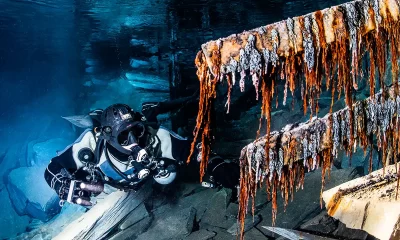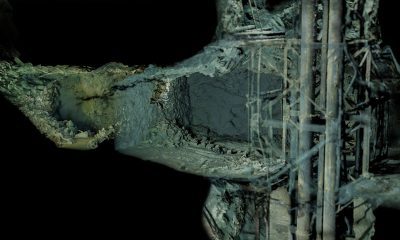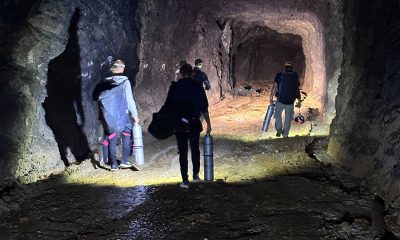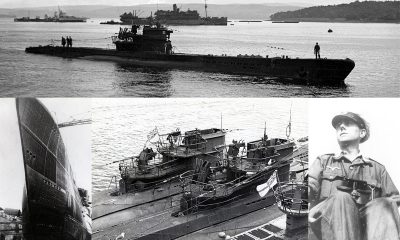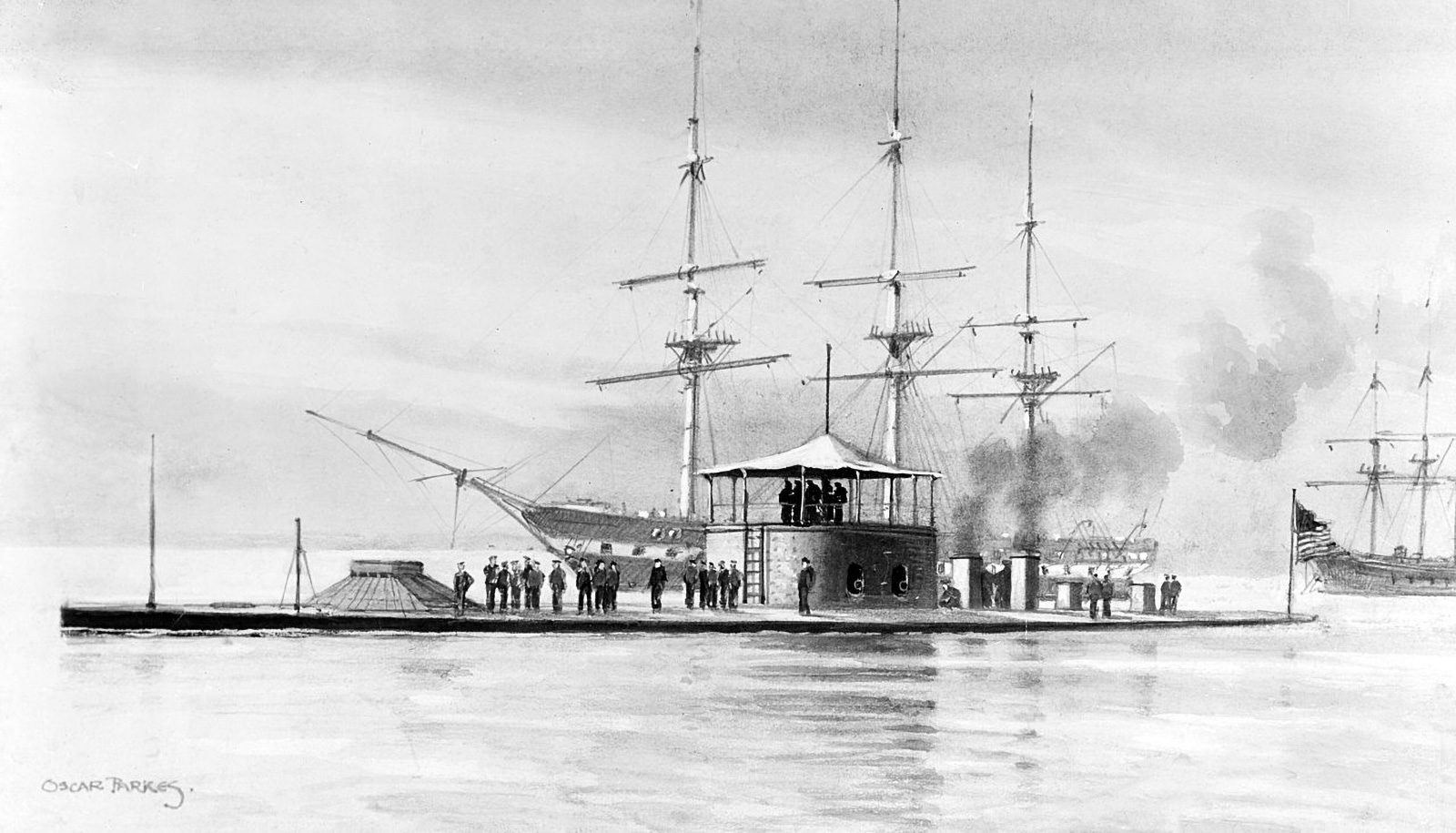
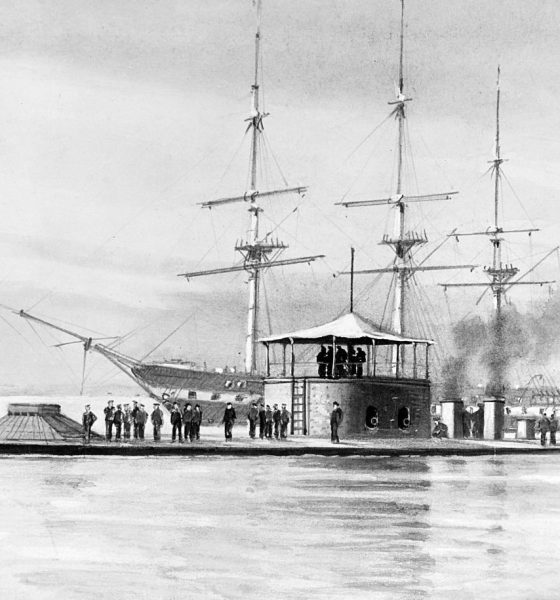
Exploration
Mine Over Monitor: Iconic dive sites with a shared history
What does Sweden’s flooded Långban mine—a wellspring of u/w exploration and mapping for more than 16 years—have to do with the famed Civil War ironclad, the USS Monitor that figured prominently in the history of tech diving? Finnish Scientific Diving Academy coordinator Edd Stockdale takes us for an improbable dive into history!
by Edd Stockdale. Images by Edd Stockdale unless otherwise noted. Header image: USS Monitor. Watercolor by Oscar Parkes, public domain.
In the center of Sweden is a region known as Bergslagen featuring—due to its hugely diverse mineralogy—hundreds of years of mining history. The region boasts many abandoned mines (some flooded, others not) in addition to active sites. One specifically stands out with regards to its geology and, in terms of diving, its connection to an iconic US dive location.
Långban (pronounced long-ban), a three-and-a-half hours westward drive from Stockholm, is both the name of the village and the mine where extraction began as early as the 1500s. Mining activity grew dramatically in the mid 1700s and continued until 1972 when the mine closed. With the pumps shut off, the lakes on both sides flooded the mine.
In geological terms, the mine features one of the highest recorded diversities of minerals found in a single working site, with over 270 unique minerals identified—70 of which are unique to Långban itself.

These days, the village is home to the Långban Mining Museum and residents, some of whom were once miners there. Underneath the surface, clear water floods the entire mine, preserving the structures and all evidence of industrial mining and providing a stunning diving locale.
Around 2005, divers began exploring the mine. In conjunction with the museum, divers formed the Långban Dyksällskap (diving association). They allowed access to the site and documented their efforts to promote a wider understanding of the site for visitors. Documentation included videos for general access around the museum site, photos of specific sections of interest for displays, and—more recently—early 3D models from photogrammetry.
Year round, the mine features a 6°C/43°F water temp and visibility up to 40 m/131 ft, making it ideal for diving. Plus, the mine is open to all qualified divers interested in the industrial history of the area.
Diving Access
To facilitate better access, divers have spent the last 16 years working in the shallow areas to establish a main line system and are—slowly, but surely—mapping the mine’s deeper levels with work still continuing at 90 m/295 ft and onward. Due to historical laws that required mapping of all mining activities in the country, there is a publicly accessible record of Swedish mines—including Långban—which provides preliminary information for possible routes. While they’re far from accurate, the guides still offer a great insight into areas of interest.



Diving in the shallow levels, divers often encounter early working areas, particularly those accessed in the major boom period of the mid 1700s. Artifacts from that time are still present. Deeper explorations reveal more recent mining activities where the techniques and mineralogy change. Above ground, visitors can explore many of the still-standing towers and buildings preserved by the museum, providing additional context for the diving activities below.
The old mine offices are one such building; they served as the early diving association’s lodgings, and are connected to another iconic diving site—the USS Monitor. Långban was the birthplace of John (Johan) Ericsson in 1803, and his father and grandfather both held the position of mine supervisor.
Fathers of Invention

1803-1889
Due to financial difficulties, Ericsson’s father was forced from the position—and Långban. John Ericsson and his brother, Nils, followed their father to the excavation of the Göta Canal where they were quickly recognized for their extraordinary potential in engineering and surveying. After a surveying career in the Swedish military, Ericsson developed an interest in heat engines, moving to England in 1826 to establish himself as an inventor. Initial work on engines led to an interest in locomotives—both Ericsson and John Braithwaite entered The Rainhill Trials with the Novelty locomotive engine.
Ericsson developed efficient engines for ships—with success—in the years to follow. In 1835, he designed a screw propeller that was more efficient than the contemporary paddle steamers, but it was viewed with resistance from the British Navy Admiralty in the 1837 demonstration trials. As a result, Ericsson relocated to New York where there was more interest in his designs—especially by American Captain Robert Stockton, who lobbied for funding to build the US Navy’s first ship powered by a screw propeller, the USS Princeton.

The USS Princeton launched in 1843 after three years under construction, during which time relations between Stockton and Ericsson had soured. On February 27, 1844, a public reception was hosted by President Tyler during which The Princeton departed Alexandria, Virginia, on an exhibition cruise down the Potomac. Present were the President, members of his cabinet, and approximately 400 dignitaries, including Stockton.
In order to impress his guests, Stockton decided to fire the ship’s largest long gun, named Peacemaker, which he had designed and reportedly rushed into production without adequate testing, based on one of Ericsson’s innovative designs for a smaller gun. After three successful firings during the trip downriver, the gun was reloaded for a final salute to George Washington as the ship passed Mount Vernon on the return trip. However, when Stockton pulled the firing lanyard, the gun exploded and instantly killed six men, including the Secretary of State and Secretary of the Navy. Another 16-20 people were injured.
Though Stockton had built the gun based on an incorrect implementation of Ericsson’s original design, Ericsson was blamed for the tragedy, and spent many years trying to clear his name. He parted ways with the US Navy the following year, successfully dedicating himself to civilian developments. In the early 1850s, during the war between France and Great Britain, Ericsson submitted designs for a new type of armored ship to the French who declined. His invention was shelved until the outbreak of the American Civil War in 1861.
The Rise of the Ironclads
In response to the Confederacy’s conversion of the USS Merrimac into an Ironclad (eventually christened CSS Virginia), President Lincoln authorized the development of the Ironclad Board to develop a counter. He was impressed with Ericsson’s original ironclad designs intended for the French, and acquaintances and invested parties helped Ericsson and the Navy navigate their mutual distrust. Construction began in October 1861, and the ship launched on January 30, 1862.

The design resulted in a floating battery, named the USS Monitor, with the first rotating gun turret that earned its place in history at the Battle of Hampton Roads on March 8 – 9, 1862, the first battle between ironclads against the CSS Virginia. Though the battle ended in a stalemate after three hours with no significant damage inflicted, the impact of this battle changed naval design and warfare thereafter, with wooden warships being abandoned in favor of ironclads across large numbers of shipyards.

In support of the Union Army along the James River in the Peninsula Campaign, the Monitor was ordered to North Carolina. On December 31, 1862, she foundered while being towed, sinking along the way off of Cape Hatteras, resulting in the loss of 16 crew members.
The wreck was discovered in 1973 by a team led by John G. Newton from Duke University and was confirmed in 1974, finally being recognised as the first US Marine Sanctuary in 1975. It later became the source of a legal battle launched by wreck diver and historian Gary Gentile, for the rights of technical divers to dive the site on scuba.
Work by NOAA and Mariners Museum, Newport, over the following 30 years resulted in documentation of the site and identification of artifacts around the wreckage like the turret, deck guns, and other components of the wreck. In more recent explorations, divers have used 3D photogrammetry to construct a model for use by the general public.


John Ericsson became a national hero and continued his production of ironclads, later moving into torpedo designs. He developed the torpedo vessel Destroyer, and undertook numerous other inventions until his death on March 8, 1889 in New York City. His remains were transported back to Sweden after a large memorial service in New York and interred in the town of Filipstad, 20 km/12 miles from his birthplace in Långban, 63 years after his departure.
Two of the Monitor’s guns mark his memorial on the edge of the lake in town. Anyone visiting the region can visit the Långban museum, which has a section dedicated to the USS Monitor along with replicas of the vessel herself that used to float on the lake.


Exiting the door of the house he was born in on the way to dive the Långban mine, every diver will see the name on the commemorative memorial in the square showing the great connection between a small village in Sweden, above a unique mine, and one of the greatest Naval developments.

Dive Deeper
Fourth Element: Diving the USS Monitor by Joe Hoyt
InDepth: Out of the Depths: The Story of British Mine Diving by Jon Glanfield
NOAA (photogrammetry): Getting a Clear View of the USS Monitor
Gary Gentile Productions: Ironclad Legacy: Battles of the USS Monitor
Gary Gentile Productions: The Battle for the U.S.S. Monitor (DVD)
Other Stories by Edd Stockdale:
InDepth: The Swan—A 17th Century Story at the Bottom of the Baltic Sea by Edd Stockdale
InDepth: Finland’s Newly Established Scientific Diving Academy by Edd Stockdale

Edd Stockdale has worked in scientific and technical diving for over a decade and joined as Badewanne team member in 2019. He is the coordinator of the newly established Finnish Scientific Diving Academy at the University of Helsinki which was established to develop scientific diving training to further research abilities and develop new approaches to data collection in cold water based science.
When not working on research diving, Edd can be found exploring the mines and wrecks in the Nordic region or planning the next adventure. He is supported by Divesoft as well as Santi, Halcyon, and REEL Diving in Scandinavia.


















